
Ukraine and the Logistics War
Note: Much of this post based on tweets by Trent Telenko, particularly this thread and replies, links etc.
I think the Russian attack from their border south around Izyum may be in trouble. Big trouble. And the reason, if I’m right, is that they are now overextended with respect to supply lines because while they did better than the Kiev invaders to secure their supply lines, the supply base – Belgorod in Russia – is suffering a series of mysterious fires that are damaging the railways, burning fuel dumps etc. That means that even if the supply chains from Belgorod are relatively secure, though the railway down to Ukraine appears have a bridge with issues, there may well be nothing to send down them. There also won’t be any reinforcements sent down in a timely manner either if the railways are broken and those that do make it down are going to be just as short on fuel as the existing tanks etc.
If Trent, I and other twitter people are right, then a second Russian offensive is going to fail, possibly even be encircled, because of an inability to get enough supplies to the front. This, despite the Russians learning a few lessons from the debacle of Kiev. In fact about the only place where Russian logistics seem to be able to deliver enough munitions etc. is along the coastline and in the Dombas as it’s also looking to me like the Russians north of the Dniepr around Kherson are on the defensive too. In addition there are a number of reports of Ukrainian partisans in action both near Kherson and inland around Melitopol, Tokmak and further east. That’s going to hamper logistics for all the southern/central invasions if it continues.
The Ukrainian Resistance Center (the Ukrainian Ministry of Defense’s headquarters to coordinate operations within Russian-occupied territory) reported on April 16 that Ukrainian artillery targeted and destroyed ten railcars of Russian ammunition in Tomak using intelligence provided by Ukrainian civilians.[16] ISW cannot independently confirm this claim, and will be unlikely to be able to confirm similar Ukrainian claims of partisan activity in the future, but increasing Ukrainian reporting on partisan actions in southern Ukraine at minimum indicates increasing Ukrainian attention to these operations.
On the other hand the Russians have launched missiles on Lviv that seems to be intended in part to block Ukrainian resupply from the West. So far this doesn’t seem to be too successful but it is a major escalation for Russia which hasn’t done too much before to disrupt this.

Mind you if Russia is to succeed in disrupting Ukrainian logistics it’s going to need to have more reliable missiles than it currently appears to have. There are many pictures like the one above of an unexploded Russian missile somewhere in Ukraine as well as ones where they appear to have hit the target and not exploded. It needs the missiles because other than close to occupied Donetsk and Lukhansk it does not seem to have the air control to safely deploy bombers. Thus missiles launched from Russian territory are the only way it can attack without endangering very expensive aircraft. Unfortunately that means the missiles have to travel a considerable distance across Ukraine, which allows them to be tracked and shot down. Combine that with the failure rate and Russia probably needs to fire 5-10 missiles to ensure one hit.
Which brings us back to logistics again. How many such cruise missiles does Russia have in inventory? It certainly has dozens. It may have a few hundred. It probably does not have thousands. If it needs to send 10 to take out a single target the number of targets it can successfully disable are probably in the low hundreds, possibly lower. And given the sanctions on it, building new missiles to replace those fired is going to be difficult. In the near future, at least, the cruise missiles it has in inventory now are the only ones it will have.
The same goes for any number of other weapons platforms. In the shorter term that’s going to mean acute shortages of smarter munitions both offensive and defensive, because as with the missiles, once the stockpile of existing munitions and components are exhausted there probably won’t be replacements. But if you are Russian wild indiscriminate use of dumb munitions can be used to replace targeted smart munitions in many circumstances- but again we hit the logistics problem. It’s a lot easier to ship one smart munition than a dozen dumb ones. In places where Russia has functional (rail-based) logistics shipping hundreds of dumb shells, bombs and rockets is not too difficult and Russia probably does have very large stocks of these. Whether it can transport those large stocks from their storage locations to Ukraine without any mishaps is questionable, but still it is likely most of them can be transported close to Ukraine. That last few miles down contested roads may be a different story.

However in the medium/longer term the actual weapon platforms will be an issue. The Ukrainian military says Ukraine has destroyed/captured 790 tanks and so on to date – Oryxspionkop and others have documented around two thirds of that and there’s general agreement that they are missing many losses because there is no clear documentation. The important thing is that are no replacement tanks available once the stock of currently working ones are used up. Sure there are claims that Russia has 12,000+ tanks but there’s also general agreement that most of these are non-functional having last been driven (or maintained) prior to the end of the Soviet Union. Actual functional working tanks is probably at maximum ~3000. More likely it was ~3000 before the invasion and is now ~2200. I.e. a quarter gone. At best. Figure there’s another 500+ that have returned from Ukraine but are not fully functional and probably not repairable without the spare parts that do not currently exist. Many of the working tanks are either impossible to redeploy (the ones in Kaliningrad, Moldova, Armenia …) , hard to deploy (ones in/near Vladivostock) or needed to defend other borders and hot points (Georgia, Chechnya …). Russia may not have more than a couple of hundred more tanks that it CAN deploy and almost certainly they will be older T-72s and the like which we know are very vulnerable to Javelins, NLAWs and drone directed artillery.
There are similar reported problems with air defense systems. Pantsirs are pretty good close air defense systems (though they seem to have problems with drones) but they are pretty complex systems and thus vulnerable to breaking in the field. There are probably less than 100 working Pantsir systems in the entire country available for redeployment, for example, and the Russians have lost at least seven and possibly twice as many to Ukrainian action. It has probably lost more from breakdowns and lack of spare parts. Note Russia undoubtedly has more than 100 working Pantsirs outside Ukraine, but they are key for defending critical military infrastructure like airfields so the question is how many spare ones do they have and/or how many places they feel they can safely reduce coverage of (you can be absolutely sure than any place near Ukraine will not be left without a Pantsir so transportation time is also an issue). Quite likely a number of supposedly spare ones have been raided for spare parts and/or have not been properly maintained. If Russia can no longer deploy Pantsirs to defend its forces then they are vulnerable to Ukrainian airstrikes and, while Ukraine has lost some of its airforce, it still has plenty.
Human Logistics
Something else. Assuming (as I do) that the Ukrainian counts of Russian casualties are roughly accurate (i.e. they may be overstated but if so by 5-10% not 50%) then Russia has now had about 19-20,000 deaths which is 10% of its original invasion force killed – and it could be more, and certainly is way more when you add up the wounded, captured etc. In under 2 months. That’s more than they lost in ~10 years in Afghanistan. It’s way more than the US and allies lost in any war since the Vietnam war. I suspect, would need to check, that the sum total of all Western fatalities in all wars since Vietnam – Afghanistan and Iraq casualties (both wars) plus the Falklands, Yugoslavia etc. – may be less than this.
Even in Vietnam US fatalities were ~60k over roughly 20 years and the worst year was 1968 when they lost 16,899 (see here ). Russia’s military losses in Ukraine have not been seen outside of the Iran/Iraq war (or various conflicts in Africa) since the 1950s. And we’re less than 2 months in.
Those losses have included fairly senior generals (8 to date including most recently deputy commander of the 8th Army Maj Gen Vladimir Frolov) and plenty of other officers as well as significant chunks of “elite” regiments like the paratroopers. I suspect the rumors of units (and individuals) refusing to go to Ukraine are a) genuine and b) likely to increase sharply. Also I’ve seen various twitter threads where it is mentioned that much Russian armor has just two personnel instead of the expected three. Either the driver doubles as gunner or the TC doubles as gunner or vice versa. If should be noted that Russia, in general, sent its more experienced units into Ukraine. Replacements will be generally of lower calibre which means they will tend to be less effective and likely to use up more munitions and other supplies for less gain.
If Ukraine inflicts a clear defeat on another Russian invasion force (e.g. the Izyum one or the Kherson area one or both) and doesn’t in turn lose anything more than Maruipol then I don’t see Russia being able to continue fighting because it won’t have the manpower or, assuming the logistics issues continue, the weapons. I don’t mean “is unwilling” to continue, but rather “is incapable” of continuing.
This kind of reminds me of Russia in 1914/15. Putin may survive this year, but short of a miracle, I don’t see him lasting long presuming Ukraine doesn’t collapse.
Free the People publishes opinion-based articles from contributing writers. The opinions and ideas expressed do not always reflect the opinions and ideas that Free the People endorses. We believe in free speech, and in providing a platform for open dialogue. Feel free to leave a comment.



